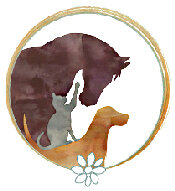
Dog videos
Ella is a 1-year-old Golden Retriever who was spayed approximately 4 months prior. She has no lameness and no current problems. Treatment of the normal internal scar or adhesion after her spay surgery will reset the balance to her pelvic bones, shoulders and some spinal vertebrae - ensuring optimum mobility as she ages. Upon evaluation of her gait, there is no lameness however very subtle short striding of her LEFT front leg is perceptible with close observation. This short striding is not present at the end, after the treatment of her spay adhesion.
Motion testing of joints revealed a loss of normal mobility in her LEFT sacroiliac (SI) joint, 2 lumbar vertebrae (L 1 – 2 ) in her mid-back, LEFT shoulder blade and upper neck vertebra/back of the skull (occiput – C1/atlas).
I released the spay adhesion/scar via gentle manipulation of the ligaments around the bladder that became slightly tighter as a normal response to surgery. This changed nerve flow to her LEFT pelvic bone and lumbar vertebrae causing them to return to a normal motion by themselves. Since the pelvis had normal motion again this changed mechanical tension in the membrane running from the pelvis to the skull/upper neck leading to better motion in the neck. A muscle from the skull to the shoulder was released allowing the LEFT shoulder blade to have normal motion again. All of this from manipulating the area of the bladder!
Exam of her LEFT knee showed a slight laxity or looseness of the cruciate ligament (ACL). This is a reversible laxity or loss of normal tone in a ligament that has not had any damage yet but is a response to mechanical changes in the whole left hind leg (especially fibula bone) that started up above with the pelvic bone (SI) restriction initiated by the spay surgery. This slightly lax ligament instantly returns to 100% snugness/normal tone when the fibula bone at the ankle is gently manipulated. This will stay normal as long as the SI joint up above has normal motion.
Dog & Cat Appointments:
Read more about ACL Injuries in dogs
Crooked Butt Syndrome (also related to spay/neuter surgery)Of the dogs that develop ACL injuries almost 100% of the time the affected knee is on the same side as the pelvic restriction (from spay/neuter issue). Not all dogs develop ACL tears, but the slight laxity on the one side is a weakness that sets the ligament up for potential future damage.
Here’s what to expect in a treatment:
Before & After with Benji
““Today was Benji’s turn to see Dr. Laura Taylor! He loved it!! I took some video this time. Clip One is before his neuter scar treatment and Clip Two is post treatment. Horses (both mares and geldings) also experience this pelvic block due to scar tissue from gelding and ovary tension when mares go into heat. The difference is amazing once the butt is on straight. Even my sister couldn’t believe how great Benji felt when she picked him up when we got home. I’ve been using Laura for 11 years and she works miracles!””
...the end result is better mobility in the dog’s hind end…more power, freedom and flexibility.




